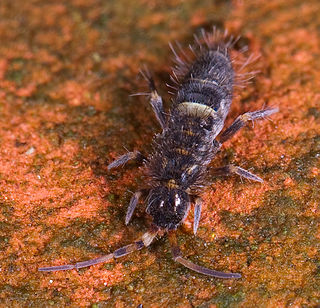
Biogeography is the study of the distribution of species and ecosystems in geographic space and through geological time. Organisms and biological communities often vary in a regular fashion along geographic gradients of latitude, elevation, isolation and habitat area. Phytogeography is the branch of biogeography that studies the distribution of plants. Zoogeography is the branch that studies distribution of animals. Mycogeography is the branch that studies distribution of fungi, such as mushrooms.
Ecological classification or ecological typology is the classification of land or water into geographical units that represent variation in one or more ecological features. Traditional approaches focus on geology, topography, biogeography, soils, vegetation, climate conditions, living species, habitats, water resources, and sometimes also anthropic factors. Most approaches pursue the cartographical delineation or regionalisation of distinct areas for mapping and planning.

Endemism is the state of a species being native to a single defined geographic location, such as an island, state, nation, country or other defined zone; organisms that are indigenous to a place are not endemic to it if they are also found elsewhere. For example, the Cape sugarbird is found exclusively in southwestern South Africa and is therefore said to be endemic to that particular part of the world.

The New Zealand flatworm is a large land flatworm native to New Zealand. It can vary from 5 mm in length when hatched to approximately 17 centimetres (6.7 in) in mature adults.
Rapoport's rule is an ecogeographical rule that states that latitudinal ranges of plants and animals are generally smaller at lower latitudes than at higher latitudes.

In biogeography, a taxon is said to have a cosmopolitan distribution if its range extends across all or most of the world in appropriate habitats. Such a taxon, usually a species, is said to exhibit cosmopolitanism or cosmopolitism. The extreme opposite of a cosmopolitan species is an endemic one, being found only in a single geographical location.
Neuquenornis volans is a species of enantiornithine birds which lived during the late Cretaceous period in today's Patagonia, Argentina. It is the only known species of the genus Neuquenornis. Its fossils were found in the Santonian Bajo de la Carpa Formation, dating from about 85-83 million years ago. This was a sizeable bird for its time, with a tarsometatarsus 46.8mm long. Informal estimates suggest that it measured nearly 30 cm (12 in) in length excluding the tail.

Rhamnus cathartica, the European buckthorn, common buckthorn, purging buckthorn, or just buckthorn, is a species of small tree in the flowering plant family Rhamnaceae. It is native to Europe, northwest Africa and western Asia, from the central British Isles south to Morocco, and east to Kyrgyzstan. It was introduced to North America as an ornamental shrub in the early 19th century or perhaps before, and is now naturalized in the northern half of the continent, and is classified as an invasive plant in several US states and in Ontario, Canada.

Geoplanidae is a family of flatworms known commonly as land planarians or land flatworms.
Neuquensuchus is an extinct genus of crocodyliform from the Santonian-age Upper Cretaceous Bajo de la Carpa Formation of Neuquén Province, Argentina. The known remains were discovered on the campus of Universidad Nacional del Comahue in the city of Neuquén. Neuquensuchus was named by Lucas E. Fiorelli and Jorge O. Calvo in a publication dated to 2007, but which became available in 2008. The type species is N. universitas, in recognition of its discovery locality. Unlike the great majority of crocodyliforms, its shin was longer than its thigh, suggesting it had some running ability.

The National University of Comahue is an Argentine national university with branches in the provinces of Neuquén, Río Negro and Chubut, with a centre in the city of Neuquén and units in Viedma, Bariloche, San Martín de los Andes, Cipolletti, Zapala, Allen, General Roca, Choele Choel, San Antonio Este, Villa Regina, Esquel, Puerto Madryn and Trelew. It is the largest public university in Argentine Patagonia.

Springtails (Collembola) form the largest of the three lineages of modern hexapods that are no longer considered insects. Although the three orders are sometimes grouped together in a class called Entognatha because they have internal mouthparts, they do not appear to be any more closely related to one another than they are to all insects, which have external mouthparts.
Silvia N. Blumenfeld is an expert on mycology. From 1986 to 2004, she was a Professor of Mycology and Biotechnology of Filamentous Fungi at the National University of Comahue, in Río Negro, Argentina. She emigrated to Israel in 2002, where she became the curator of the Tel Aviv University fungi collection, specializing in medicinal mushrooms. She has over 50 articles, books, and patents to her name, and has received academic honours. In 1995, she was awarded the Argentine National 'José Antonio Balseiro' Prize for her work.
Samuel James is an American scientist, a researcher specializing in evolutionary biology, focusing on earthworm taxonomy. James, with fellow researchers, has discovered numerous species of annelids, including Diplocardia californiana, Diplocardia woodi, Diplocardia montana, and a new species related to the Giant Palouse earthworm.

Hypochaeris chillensis also known as Brazilian cat's ear is a species of flowering plant in the daisy family. It is native to South America but has become naturalized in parts of North America, South Africa. and Taiwan. It is a common and widespread weed in the Southeast United States.
José Luis Castro Aguirre was a Mexican ichthyologist. He was a founding member of the Mexican Ichthyological Society and a member of the National System of Investigators who produced around 150 publications, focusing chiefly on the taxonomy, ecology, and biogeography of the fishes of Mexico. His 1978 book Catálogo sistemático de los peces marinos que penetran en aguas continentales de México, con aspectos zoogeográficos y ecológicos was the first catalog of estuarine fishes of Mexico. Born in Mexico City, he attended the National School of Biological Sciences at the National Polytechnic Institute (ENCB-IPN) earning a master's degree in 1974 and a PhD in 1986. He worked at the National Fisheries Institute and the Food and Agriculture Organization in the 1960s, and later was professor and researcher at the ENCB-IPN, Universidad Autónoma Metropolitana, the Interdisciplinary Center of Marine Science and Northeast Center of Biological Research. He described around a dozen fish species, including several species of shark. A book of research papers in his honor was produced in 2012, and he was posthumously commemorated in the names of the fish species Hypoplectrus castroaguirrei and Eugerres castroaguirrei.
Martin Dario Ezcurra is an Argentinian born palaeontologist naming many extinct genera such as Aerotitan, Lophostropheus and Powellvenator.

Rafael Jordana Butticaz is a Spanish scientist, Emeritus Professor of Animal Physiology and Zoology, and specialist in springtails (Collembola).

The School of Languages (FADEL) is one of the 17 schools that constitute the National University of Comahue in Argentina. It is located in General Roca, province of Río Negro. It has 800 students, but with the Department of Foreign Languages for Specific Purposes (DIEPE), located in the city of Neuquén, it provides services to the over 35,000 active students attending its courses in any of the 76 undergraduate and postgraduate programs offered in the different academic units in the provinces of Río Negro and Neuquén.

Pyotr Petrovich Vtorov was a Soviet scientist biogeographer, ecologist, zoologist and nature conservation activist. He founded a new direction of scientific research called Synthetic Biogeography, and developed a scientific concept for the creation of reference areas of the biosphere. He was an author of textbooks, a guide to birds, scientific and popular books.











